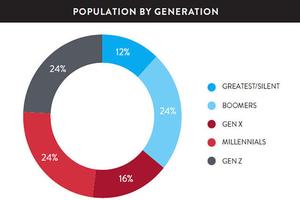
Senior Pastor
August 2016
The tremor of the spiritual tectonic shift is felt in all the religious landscapes of America. We at First Baptist Church Santa Clara must respond to this radical change with a radical message. The task is daunting, but we have Jesus, who was a radical leader with a radical message. Today, we are ministering and leading more than four generations in the city and within our own church.
- Generation Z - Born roughly between 1995 and 2012
- Generation Y - Born roughly between 1980 and 2000
- Generation X - Born between 1964 and 1980
- Boomers - Born between 1946 and 1964
- Greatest/Silent - Born between 1925 and 1946
The daunting challenge for the church and her leaders, now and in future, will be to reach and retain faithful followers for Jesus Christ, to disciple them, and to equip them for the kingdom ministry. It is by no means easy to disciple and lead more than four generations to be faithful followers of Jesus Christ.
Each generation has its own distinct religious practices, values, and sets of belief. How then can we successfully reach and retain a multi-generational membership and integrate it into the life of the church? One solution is for the church is to embrace radical changes in leadership, messaging and outreach, and to create a spiritual culture that actively demonstrates respect and inclusion for its multigenerational members.
Reaching More Than 4 Generations
As these generations interact, churches can no longer assume that the sermons, teaching, discipleship and evangelism that worked in the past will work today. America has become spiritually pluralistic and is also suspicious of organized religion. In the book Families and Faith, it states that starting in the 1960s church attendance gradually declined, with the sharpest decrease occurring in the period from 1970 to 1980. Attendance then increased until 1986, but made another sharp downturn in the 1990s, followed by participation creeping up and then down again in the 2000s. Today, churches and leaders must find creative and authentic ways to reach and retain faithful followers of Jesus.
Religious Landscape
According to my research and readings, the Silent and Boomer Generations place the most value on communion, followed by a traditional style of worship and sermons/preaching/Bible teaching.
For Generations X and Y, the sermon and contemporary worship are valued most, followed by children's and youth ministries.
Generations X and Y also want to use their gifts in leadership and ministry, while the older generations want worship services to nurture their faith.
Generation Z embodies diversity. If an institution such as the Church were racist, sexist or otherwise exclusive of certain groups, they would be less than impressed.
Christianity Today also reports that Generation Z is more morally conservative than its elders.That's a surprising twist in the tale for anyone who assumes a new generation brings an ever-more relaxed set of social morals. Generation Z is a perfect example, as its members aren't necessarily more socially liberal than their older brothers and sisters.
The Nones (religiously unaffiliated) see religion and spirituality as separate things. Individuals among the Nones are creating their own spirituality, mixing different sets of belief with different kinds of faith.
It is vital for the church and its leaders to understand the religious landscape of different generations in order to reach them with the Good News of the Kingdom.
Family Landscape
Families in America have changed. Many of us had stay-at-home moms. Now, stay-at-home dads are no longer a new thing. Men are not the only bread-earners anymore either, as there are now many women bread-earners, too.
One in two marriages in the U.S. now ends in divorce, and more than 40% of children are born out of wedlock in America. It has also been reported in the UK that even more than 40% of children will be born out of wedlock there in 2016.
Single parents have increased in this nation. Blended families with step-parents and step-siblings have also increased.
You've probably heard the term "helicopter parenting" in relation to Generation X. If not, it's when a parent pays extremely close attention to a child's experiences and problems, particularly at school. Generation Y was also helicopter-parented.
These rapidly changing family landscapes require radical responses from the church. The Gospel is radical and we must present it so that its message is relevant to all generations.
Youth Landscape
The Baby Boomers are known as a generation of seekers. Generation X is known for being skeptical. The Millennials are known as the instant gratification generation. And with every aspect of life now just a mouse click away, Generation Z is known as the iPad generation.
Reaching and leading four generations with different religious and family landscapes are a daunting challenge, but not a new one.
Look To God To Lead
God led Abraham, Isaac, Jacob and Joseph - four generations. He chose them to lead different people, in different places and in different times. Yet, God’s word and promises remained the same. He related to four different generations of people in four different contexts, but the message always remained relevant.
Look To Jesus To Lead
Jesus interacted with the Jews, Romans, Samaritans and Christians (His followers). His message was the same, but He presented it differently to effectively reach all the people.
Look To The Holy Spirit To Lead
The Holy Spirit led the churches in Jerusalem, Antioch, Athens and Rome. Each of these churches experienced the Holy Spirit differently, but the witness was the same: The Holy Spirit testified and bore witness to Jesus Christ.
